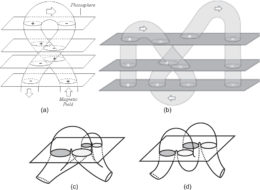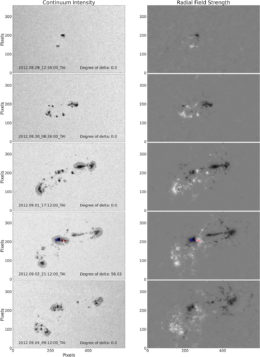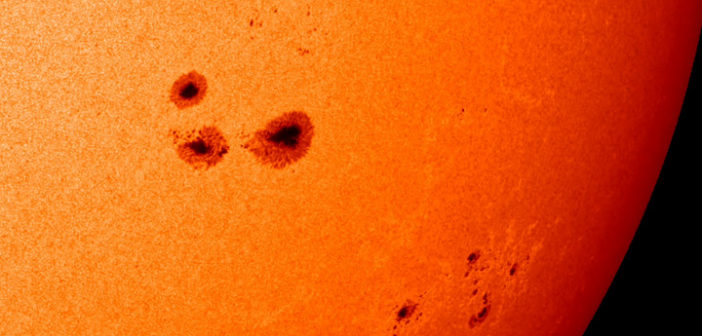What makes some sunspots produce solar flares while others don’t? A recent research article compares the properties of common, quiescent sunspots to those that are raring to flare.

The magnetic field of this single, large sunspot pair was mapped by the Helioseismic and Magnetic Imager on the Solar Dynamics Observatory. The outward-pointing magnetic field is white and the inward-pointing magnetic field is black. [NASA/Solar Dynamics Observatory]
From Sunspots to Solar Flares
Sunspots form where the Sun’s magnetic field pokes through the solar surface, creating small regions of cool, dark plasma. Sunspots are dark only in comparison to the surrounding solar surface; if you could scoop out a sunspot and hold it against the night sky, it would shine brighter than the Moon.
While many sunspots form and fade without incident, some are associated with bursts of high-energy radiation called solar flares. A longstanding goal of solar physics is to understand the conditions that lead to solar flares and other solar outbursts, which can, in turn, help us understand the Sun’s complex magnetic field. The question is, what makes some sunspots flare rather than fade?
Characterizing Sunspots
Some sunspot terminology before we dig into the details: when you look at an image of a sunspot, you’ll see a dark spot ringed by a slightly lighter area. The dark spot at the center is the umbra (Latin for “shade”), where the magnetic field is the strongest and runs nearly vertically out of or into the Sun’s surface. The surrounding area is the penumbra, where the magnetic field is weaker and less vertical.

Four possible configurations of the solar magnetic field that could create delta sunspots. Click to enlarge. [Norton et al. 2022]
Aimee Norton (Stanford University) and collaborators used data from the Helioseismic and Magnetic Imager aboard the Solar Dynamics Orbiter to compare the characteristics of sunspot groups that contain magnetic knots, called delta sunspots, to those that don’t, called beta sunspots. Beta sunspots are common, making up 64% of all sunspots, but they are less likely to be associated with solar flares than delta sunspots.
Delta Versus Beta

Intensity (left column) and magnetic field strength and direction (right column) for a single active region at five different times. The sunspots within the active region move into and out of the delta configuration over several days. [Norton et al. 2022]
The team also sought to understand whether delta and beta sunspots tended to follow established trends, such as the leading sunspot in a pair being located closer to the equator than the trailing sunspot. Intriguingly, delta sunspots are much more likely to break the rules, bucking established trends 72% of the time while beta sunspots fell in line all but 9% of the time.
This work presents an important step along the path to understanding why some sunspots are associated with solar flares. For a complete analysis of the properties of delta and beta sunspots, be sure to check out the original research article linked below!
Citation
“Characterizing the Umbral Magnetic Knots of δ-Sunspots,” Aimee A. Norton et al 2022 ApJ 938 117. doi:10.3847/1538-4357/ac8eb2

